Comparative Study: Cost Accounting Methods in Manufacturing Companies
VerifiedAdded on 2023/05/27
|26
|8219
|162
Report
AI Summary
This report examines the transition from traditional to modern cost accounting methods within manufacturing companies. It begins by outlining the limitations of traditional methods, which were developed in the mid-20th century and focused on manufacturing costs and overhead allocation, in the face of modern challenges such as technological advancements, changing consumer preferences, and global competition. The paper then introduces modern cost accounting methods, emphasizing their focus on cost rationalization and reduction. It highlights the importance of these methods in providing management with accurate information on product, project, and activity effectiveness. The report discusses Activity-Based Costing (ABC) as a key modern method, emphasizing its role in more accurately determining product profitability. Furthermore, it stresses that modern methods should be applied alongside traditional methods for a comprehensive understanding of costs across both short-term and long-term perspectives, including the entire product life cycle. The report also touches upon the core elements of costing systems, different types of costing systems like job order, process, and ABC, and the cost allocation in both traditional and ABC systems, including the importance of selecting appropriate cost drivers.
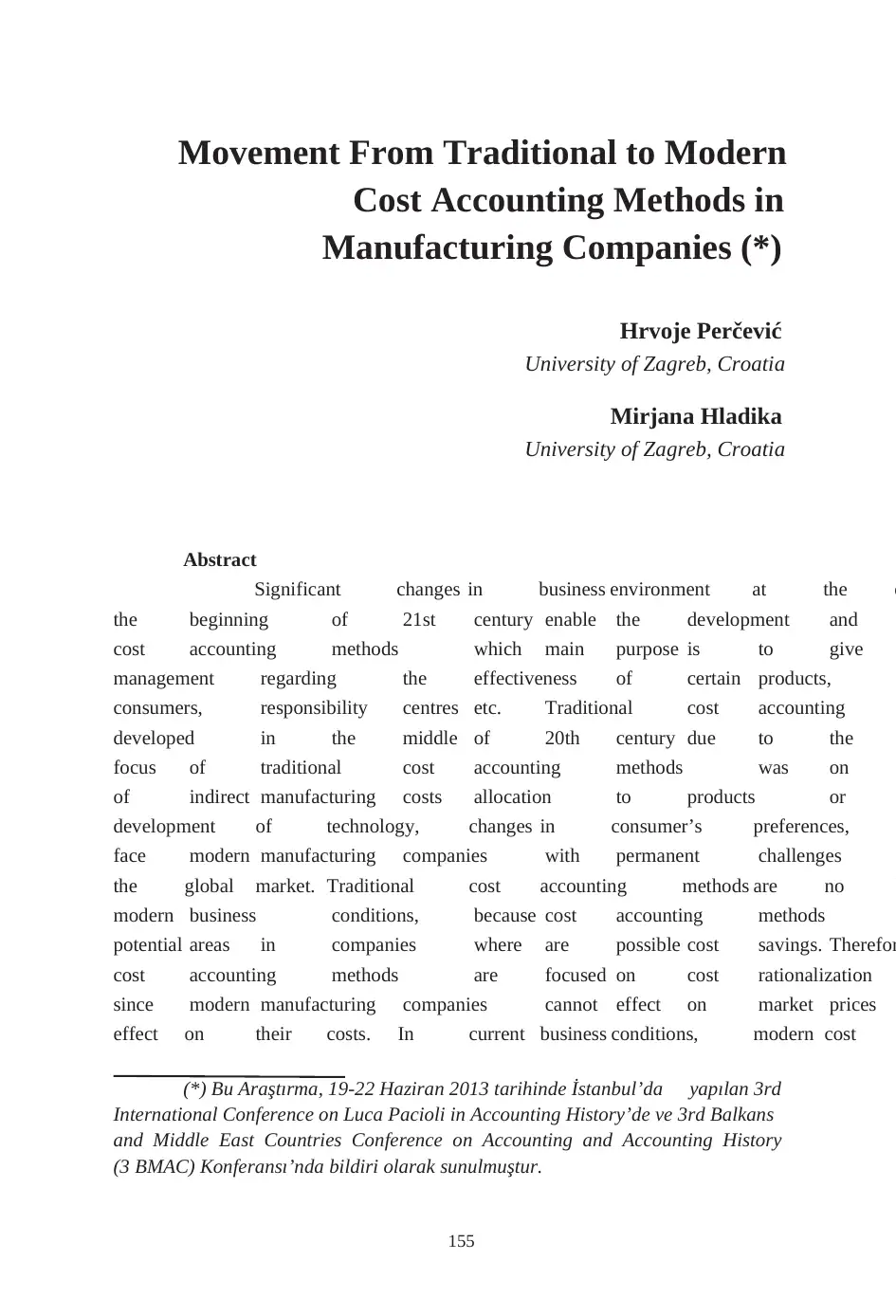
155
Movement From Traditional to Modern
Cost Accounting Methods in
Manufacturing Companies (*)
Hrvoje Perčević
University of Zagreb, Croatia
Mirjana Hladika
University of Zagreb, Croatia
Abstract
Significant changes in business environment at the e
the beginning of 21st century enable the development and
cost accounting methods which main purpose is to give
management regarding the effectiveness of certain products,
consumers, responsibility centres etc. Traditional cost accounting
developed in the middle of 20th century due to the
focus of traditional cost accounting methods was on
of indirect manufacturing costs allocation to products or
development of technology, changes in consumer’s preferences, g
face modern manufacturing companies with permanent challenges
the global market. Traditional cost accounting methods are no l
modern business conditions, because cost accounting methods
potential areas in companies where are possible cost savings. Therefor
cost accounting methods are focused on cost rationalization
since modern manufacturing companies cannot effect on market prices
effect on their costs. In current business conditions, modern cost a
(*) Bu Araştırma, 19-22 Haziran 2013 tarihinde İstanbul’da yapılan 3rd
International Conference on Luca Pacioli in Accounting History’de ve 3rd Balkans
and Middle East Countries Conference on Accounting and Accounting History
(3 BMAC) Konferansı’nda bildiri olarak sunulmuştur.
Movement From Traditional to Modern
Cost Accounting Methods in
Manufacturing Companies (*)
Hrvoje Perčević
University of Zagreb, Croatia
Mirjana Hladika
University of Zagreb, Croatia
Abstract
Significant changes in business environment at the e
the beginning of 21st century enable the development and
cost accounting methods which main purpose is to give
management regarding the effectiveness of certain products,
consumers, responsibility centres etc. Traditional cost accounting
developed in the middle of 20th century due to the
focus of traditional cost accounting methods was on
of indirect manufacturing costs allocation to products or
development of technology, changes in consumer’s preferences, g
face modern manufacturing companies with permanent challenges
the global market. Traditional cost accounting methods are no l
modern business conditions, because cost accounting methods
potential areas in companies where are possible cost savings. Therefor
cost accounting methods are focused on cost rationalization
since modern manufacturing companies cannot effect on market prices
effect on their costs. In current business conditions, modern cost a
(*) Bu Araştırma, 19-22 Haziran 2013 tarihinde İstanbul’da yapılan 3rd
International Conference on Luca Pacioli in Accounting History’de ve 3rd Balkans
and Middle East Countries Conference on Accounting and Accounting History
(3 BMAC) Konferansı’nda bildiri olarak sunulmuştur.
Paraphrase This Document
Need a fresh take? Get an instant paraphrase of this document with our AI Paraphraser
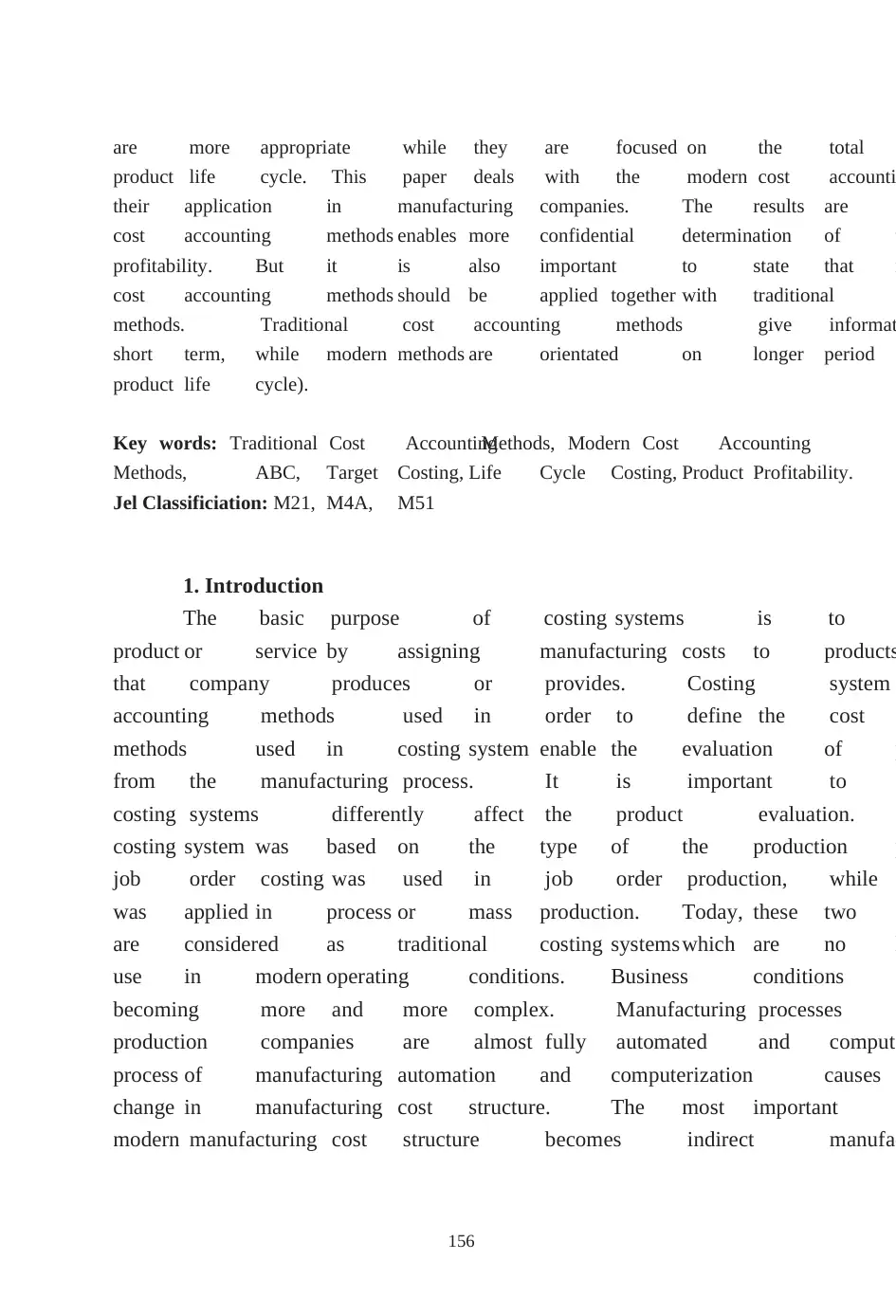
156
are more appropriate while they are focused on the total
product life cycle. This paper deals with the modern cost accounti
their application in manufacturing companies. The results are s
cost accounting methods enables more confidential determination of t
profitability. But it is also important to state that r
cost accounting methods should be applied together with traditional c
methods. Traditional cost accounting methods give informat
short term, while modern methods are orientated on longer period (
product life cycle).
Key words: Traditional Cost AccountingMethods, Modern Cost Accounting
Methods, ABC, Target Costing, Life Cycle Costing, Product Profitability.
Jel Classificiation: M21, M4A, M51
1. Introduction
The basic purpose of costing systems is to
product or service by assigning manufacturing costs to products
that company produces or provides. Costing system
accounting methods used in order to define the cost
methods used in costing system enable the evaluation of p
from the manufacturing process. It is important to
costing systems differently affect the product evaluation.
costing system was based on the type of the production p
job order costing was used in job order production, while
was applied in process or mass production. Today, these two c
are considered as traditional costing systemswhich are no l
use in modern operating conditions. Business conditions a
becoming more and more complex. Manufacturing processes
production companies are almost fully automated and compute
process of manufacturing automation and computerization causes s
change in manufacturing cost structure. The most important c
modern manufacturing cost structure becomes indirect manufac
are more appropriate while they are focused on the total
product life cycle. This paper deals with the modern cost accounti
their application in manufacturing companies. The results are s
cost accounting methods enables more confidential determination of t
profitability. But it is also important to state that r
cost accounting methods should be applied together with traditional c
methods. Traditional cost accounting methods give informat
short term, while modern methods are orientated on longer period (
product life cycle).
Key words: Traditional Cost AccountingMethods, Modern Cost Accounting
Methods, ABC, Target Costing, Life Cycle Costing, Product Profitability.
Jel Classificiation: M21, M4A, M51
1. Introduction
The basic purpose of costing systems is to
product or service by assigning manufacturing costs to products
that company produces or provides. Costing system
accounting methods used in order to define the cost
methods used in costing system enable the evaluation of p
from the manufacturing process. It is important to
costing systems differently affect the product evaluation.
costing system was based on the type of the production p
job order costing was used in job order production, while
was applied in process or mass production. Today, these two c
are considered as traditional costing systemswhich are no l
use in modern operating conditions. Business conditions a
becoming more and more complex. Manufacturing processes
production companies are almost fully automated and compute
process of manufacturing automation and computerization causes s
change in manufacturing cost structure. The most important c
modern manufacturing cost structure becomes indirect manufac
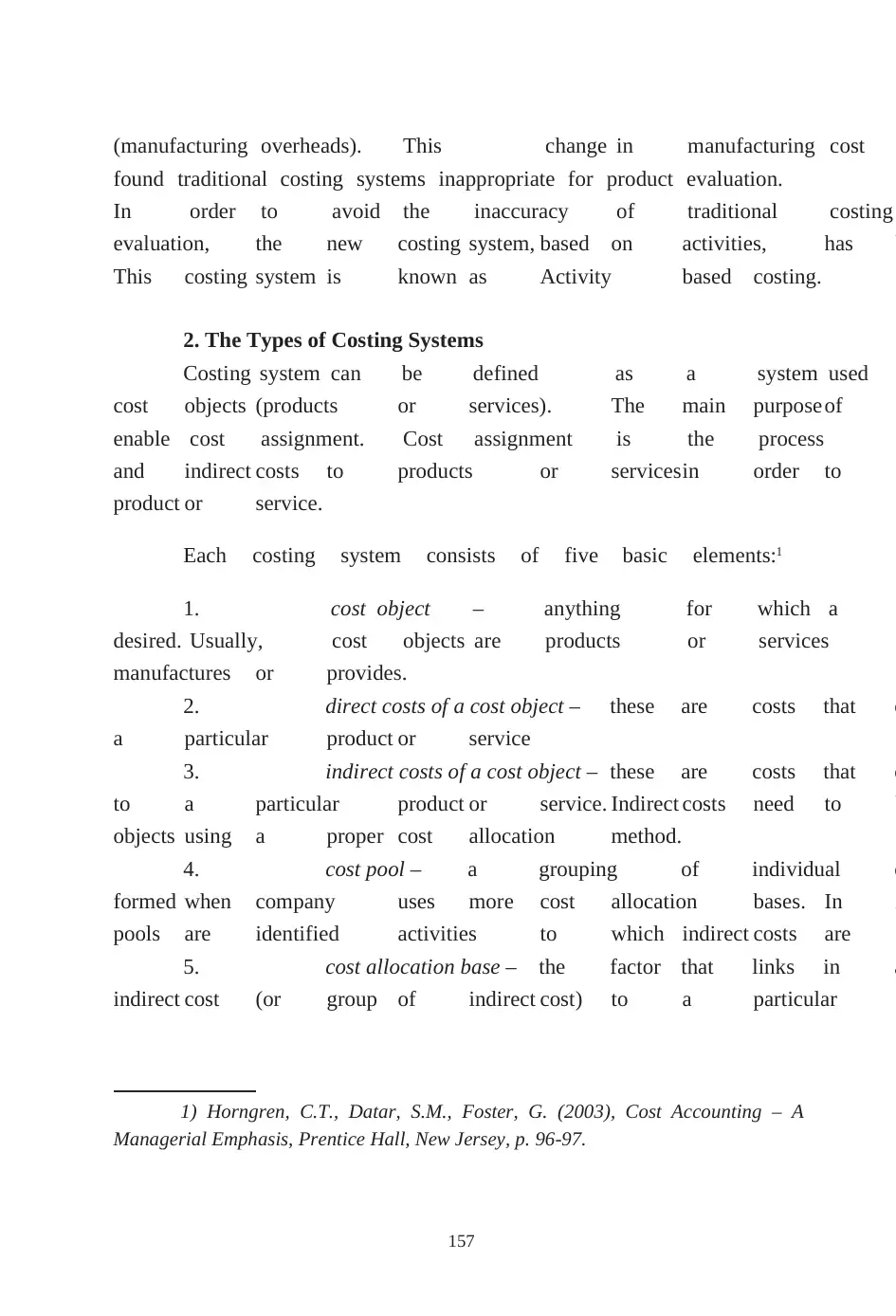
157
(manufacturing overheads). This change in manufacturing cost
found traditional costing systems inappropriate for product evaluation.
In order to avoid the inaccuracy of traditional costing
evaluation, the new costing system, based on activities, has b
This costing system is known as Activity based costing.
2. The Types of Costing Systems
Costing system can be defined as a system used
cost objects (products or services). The main purposeof c
enable cost assignment. Cost assignment is the process
and indirect costs to products or servicesin order to d
product or service.
Each costing system consists of five basic elements:1
1. cost object – anything for which a
desired. Usually, cost objects are products or services
manufactures or provides.
2. direct costs of a cost object – these are costs that c
a particular product or service
3. indirect costs of a cost object – these are costs that c
to a particular product or service. Indirect costs need to b
objects using a proper cost allocation method.
4. cost pool – a grouping of individual c
formed when company uses more cost allocation bases. In A
pools are identified activities to which indirect costs are a
5. cost allocation base – the factor that links in a
indirect cost (or group of indirect cost) to a particular c
1) Horngren, C.T., Datar, S.M., Foster, G. (2003), Cost Accounting – A
Managerial Emphasis, Prentice Hall, New Jersey, p. 96-97.
(manufacturing overheads). This change in manufacturing cost
found traditional costing systems inappropriate for product evaluation.
In order to avoid the inaccuracy of traditional costing
evaluation, the new costing system, based on activities, has b
This costing system is known as Activity based costing.
2. The Types of Costing Systems
Costing system can be defined as a system used
cost objects (products or services). The main purposeof c
enable cost assignment. Cost assignment is the process
and indirect costs to products or servicesin order to d
product or service.
Each costing system consists of five basic elements:1
1. cost object – anything for which a
desired. Usually, cost objects are products or services
manufactures or provides.
2. direct costs of a cost object – these are costs that c
a particular product or service
3. indirect costs of a cost object – these are costs that c
to a particular product or service. Indirect costs need to b
objects using a proper cost allocation method.
4. cost pool – a grouping of individual c
formed when company uses more cost allocation bases. In A
pools are identified activities to which indirect costs are a
5. cost allocation base – the factor that links in a
indirect cost (or group of indirect cost) to a particular c
1) Horngren, C.T., Datar, S.M., Foster, G. (2003), Cost Accounting – A
Managerial Emphasis, Prentice Hall, New Jersey, p. 96-97.
⊘ This is a preview!⊘
Do you want full access?
Subscribe today to unlock all pages.

Trusted by 1+ million students worldwide
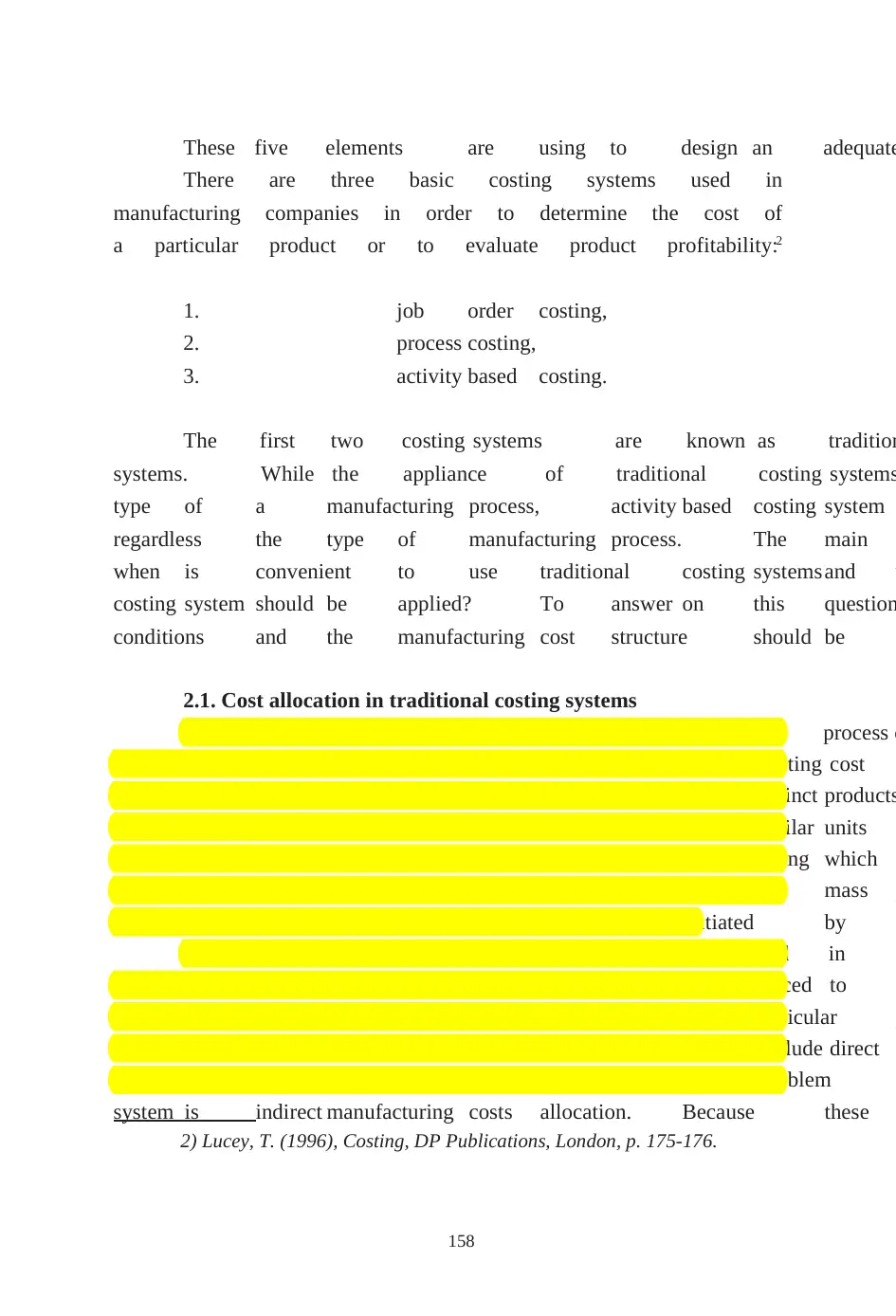
158
These five elements are using to design an adequate
There are three basic costing systems used in
manufacturing companies in order to determine the cost of
a particular product or to evaluate product profitability:2
1. job order costing,
2. process costing,
3. activity based costing.
The first two costing systems are known as tradition
systems. While the appliance of traditional costing systems
type of a manufacturing process, activity based costing system c
regardless the type of manufacturing process. The main i
when is convenient to use traditional costing systemsand w
costing system should be applied? To answer on this question
conditions and the manufacturing cost structure should be c
2.1. Cost allocation in traditional costing systems
The basic distinction between job costing and process c
is in determination of cost object. In job costing cost
consistsof a unit or multiple units of distinct products
costing cost object is masses of identical or similar units o
Therefore, job costing can be applied in manufacturing which i
customer’s order, while process costing can be used in mass p
is continually performing and is not initiated by a
Cost allocation is similar in job costing and in
both costing systems direct manufacturing costs are traced to
services. These costs are directly assigned to particular p
which cause their appearance. Direct manufacturing costs include direct
material costs and direct labour costs. The main problem
system is indirect manufacturing costs allocation. Because these c
2) Lucey, T. (1996), Costing, DP Publications, London, p. 175-176.
These five elements are using to design an adequate
There are three basic costing systems used in
manufacturing companies in order to determine the cost of
a particular product or to evaluate product profitability:2
1. job order costing,
2. process costing,
3. activity based costing.
The first two costing systems are known as tradition
systems. While the appliance of traditional costing systems
type of a manufacturing process, activity based costing system c
regardless the type of manufacturing process. The main i
when is convenient to use traditional costing systemsand w
costing system should be applied? To answer on this question
conditions and the manufacturing cost structure should be c
2.1. Cost allocation in traditional costing systems
The basic distinction between job costing and process c
is in determination of cost object. In job costing cost
consistsof a unit or multiple units of distinct products
costing cost object is masses of identical or similar units o
Therefore, job costing can be applied in manufacturing which i
customer’s order, while process costing can be used in mass p
is continually performing and is not initiated by a
Cost allocation is similar in job costing and in
both costing systems direct manufacturing costs are traced to
services. These costs are directly assigned to particular p
which cause their appearance. Direct manufacturing costs include direct
material costs and direct labour costs. The main problem
system is indirect manufacturing costs allocation. Because these c
2) Lucey, T. (1996), Costing, DP Publications, London, p. 175-176.
Paraphrase This Document
Need a fresh take? Get an instant paraphrase of this document with our AI Paraphraser
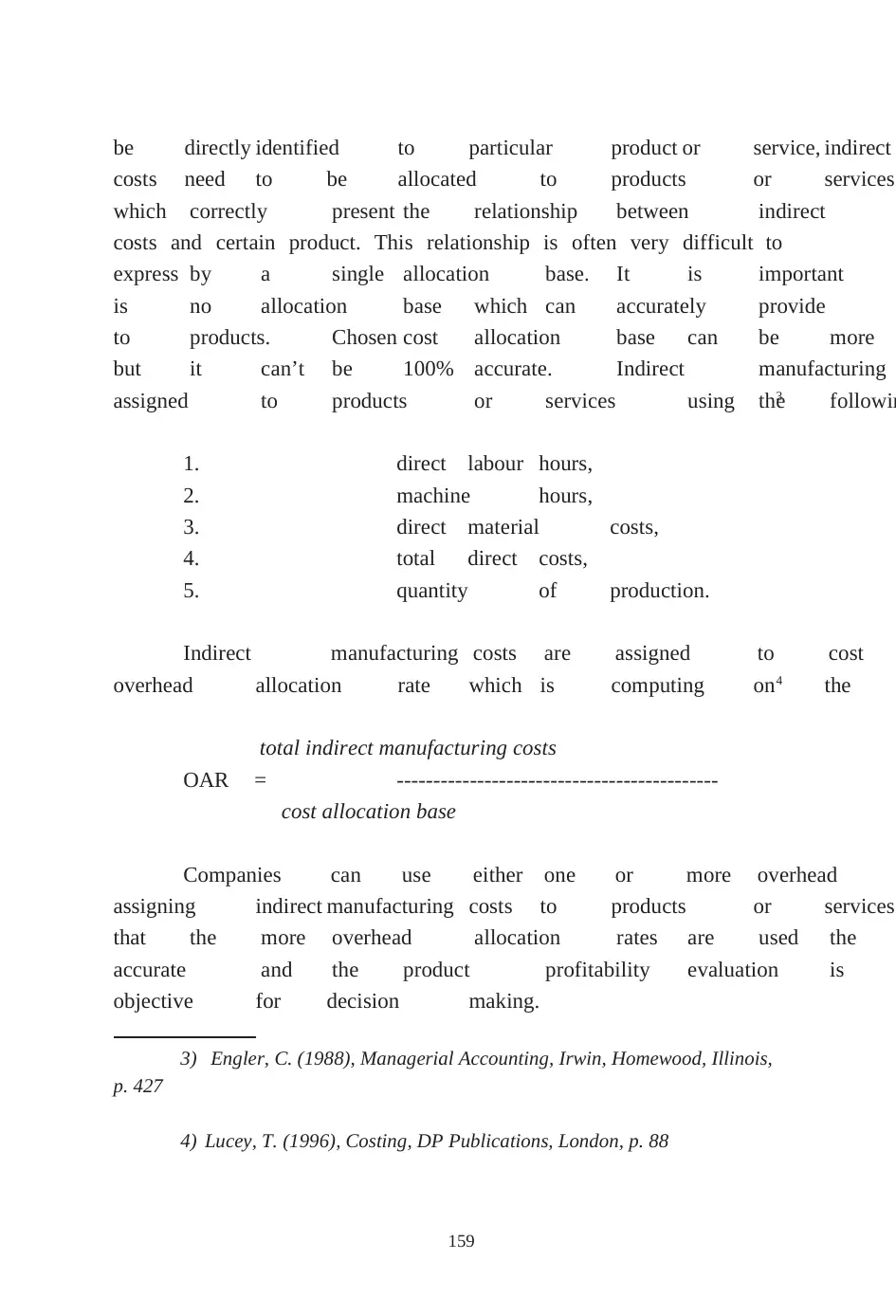
159
be directly identified to particular product or service, indirect m
costs need to be allocated to products or serviceso
which correctly present the relationship between indirect
costs and certain product. This relationship is often very difficult to
express by a single allocation base. It is important
is no allocation base which can accurately provide
to products. Chosen cost allocation base can be more
but it can’t be 100% accurate. Indirect manufacturing
assigned to products or services using the followin3
1. direct labour hours,
2. machine hours,
3. direct material costs,
4. total direct costs,
5. quantity of production.
Indirect manufacturing costs are assigned to cost
overhead allocation rate which is computing on the c4
total indirect manufacturing costs
OAR = --------------------------------------------
cost allocation base
Companies can use either one or more overhead
assigning indirect manufacturing costs to products or services.
that the more overhead allocation rates are used the
accurate and the product profitability evaluation is
objective for decision making.
3) Engler, C. (1988), Managerial Accounting, Irwin, Homewood, Illinois,
p. 427
4) Lucey, T. (1996), Costing, DP Publications, London, p. 88
be directly identified to particular product or service, indirect m
costs need to be allocated to products or serviceso
which correctly present the relationship between indirect
costs and certain product. This relationship is often very difficult to
express by a single allocation base. It is important
is no allocation base which can accurately provide
to products. Chosen cost allocation base can be more
but it can’t be 100% accurate. Indirect manufacturing
assigned to products or services using the followin3
1. direct labour hours,
2. machine hours,
3. direct material costs,
4. total direct costs,
5. quantity of production.
Indirect manufacturing costs are assigned to cost
overhead allocation rate which is computing on the c4
total indirect manufacturing costs
OAR = --------------------------------------------
cost allocation base
Companies can use either one or more overhead
assigning indirect manufacturing costs to products or services.
that the more overhead allocation rates are used the
accurate and the product profitability evaluation is
objective for decision making.
3) Engler, C. (1988), Managerial Accounting, Irwin, Homewood, Illinois,
p. 427
4) Lucey, T. (1996), Costing, DP Publications, London, p. 88
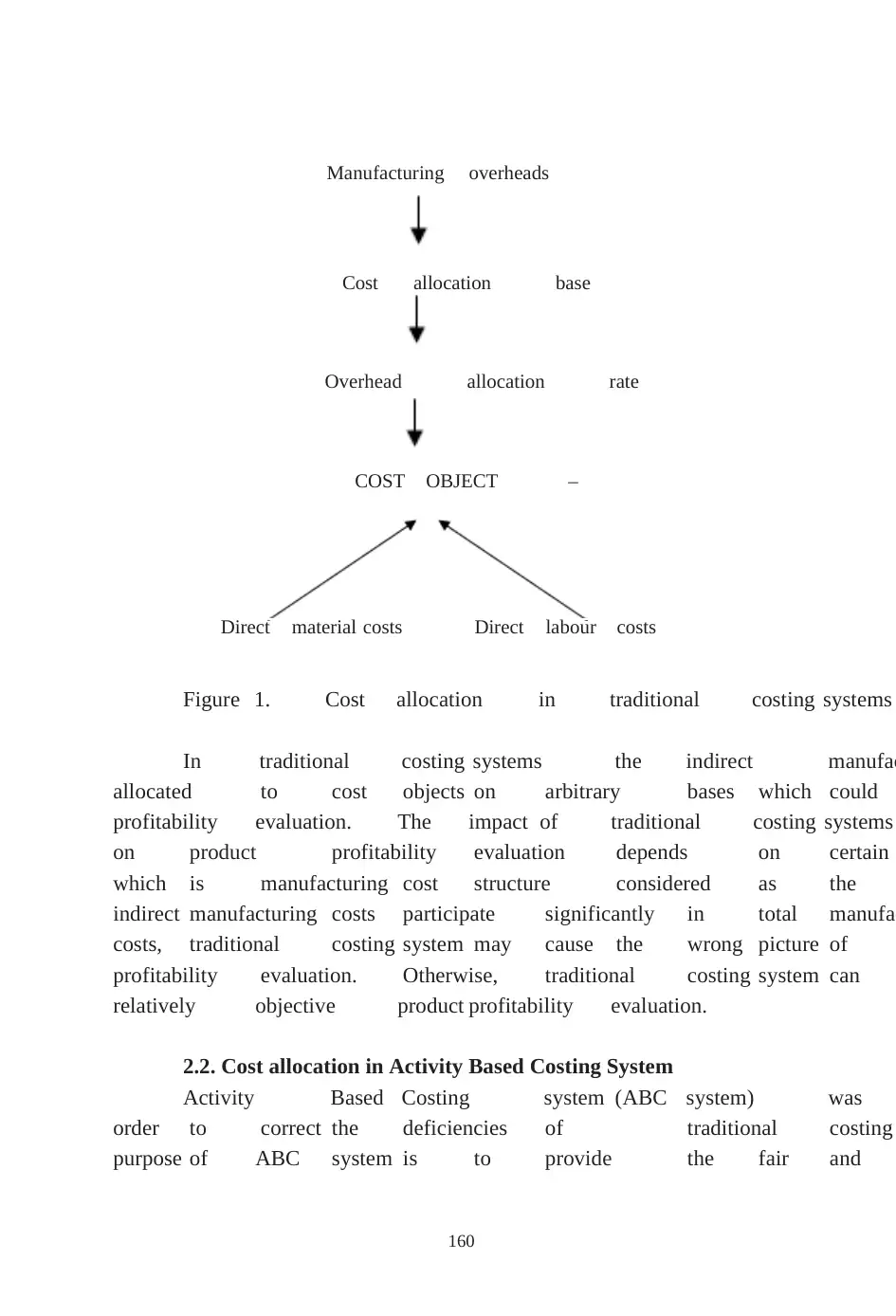
160
Figure 1. Cost allocation in traditional costing systems
In traditional costing systems the indirect manufac
allocated to cost objects on arbitrary bases which could
profitability evaluation. The impact of traditional costing systemsa
on product profitability evaluation depends on certain
which is manufacturing cost structure considered as the
indirect manufacturing costs participate significantly in total manufac
costs, traditional costing system may cause the wrong picture of
profitability evaluation. Otherwise, traditional costing system can
relatively objective product profitability evaluation.
2.2. Cost allocation in Activity Based Costing System
Activity Based Costing system (ABC system) was
order to correct the deficiencies of traditional costing
purpose of ABC system is to provide the fair and
Cost allocation base
Overhead allocation rate
COST OBJECT –
Direct material costs Direct labour costs
Manufacturing overheads
Figure 1. Cost allocation in traditional costing systems
In traditional costing systems the indirect manufac
allocated to cost objects on arbitrary bases which could
profitability evaluation. The impact of traditional costing systemsa
on product profitability evaluation depends on certain
which is manufacturing cost structure considered as the
indirect manufacturing costs participate significantly in total manufac
costs, traditional costing system may cause the wrong picture of
profitability evaluation. Otherwise, traditional costing system can
relatively objective product profitability evaluation.
2.2. Cost allocation in Activity Based Costing System
Activity Based Costing system (ABC system) was
order to correct the deficiencies of traditional costing
purpose of ABC system is to provide the fair and
Cost allocation base
Overhead allocation rate
COST OBJECT –
Direct material costs Direct labour costs
Manufacturing overheads
⊘ This is a preview!⊘
Do you want full access?
Subscribe today to unlock all pages.

Trusted by 1+ million students worldwide

161
and therefore product profitability evaluation also. Accordin
system focuses attention on indirect manufacturing costs. The aim i
the most appropriate way for indirect manufacturing costs a
objects.
The main assumption
consume activities and activities consume resources.5 The more
activities are set up, the more complex is ABCsystem. An activity
is defined as any event, action, transaction
incurs cost when producing a product or providing a service.6
In ABCsystem direct manufacturing costs are also directly traced to
products or services, so the main attention is p
costs which are allocated to activities instead to departments or jobs
(like in traditional systems). Basically, the application
going through two main phases. In the first phase indirect
costs are allocated to activity cost pools. It is
correlation between particular indirect manufacturing cost
activity. Every indirect manufacturing cost must be assigned
activity which causes its occurrence. The second phase in ABC
is assigning indirect manufacturing costs from activity cost pools to
products using defined cost drivers. A cost driver
that has a direct cause – effect relationship with the7
ABC system uses multiple cost allocation bases to assign i
costs to products or services. The usage of multiple
provide a more accurate and objective product profitability e
5) Horngren, C.T., Datar, S.M., Foster, G. (2003), Cost Accounting – A
Managerial Emphasis, Prentice Hall, New Jersey, p. 141.
6) Horngren, C.T., Datar, S.M., Foster, G. (2003), Cost Accounting – A
Managerial Emphasis,Prentice Hall,New Jersey, p. 141 or Weygandt, J.J., Kieso,
D.E.,Kimmel, P.D. (2005), Managerial Accounting, John Wiley & Sons, USA, p. 144.
7) Weygandt, J.J., Kieso, D.E., Kimmel, P.D. (2005), Managerial Accounting,
John Wiley & Sons, USA, p. 144.
and therefore product profitability evaluation also. Accordin
system focuses attention on indirect manufacturing costs. The aim i
the most appropriate way for indirect manufacturing costs a
objects.
The main assumption
consume activities and activities consume resources.5 The more
activities are set up, the more complex is ABCsystem. An activity
is defined as any event, action, transaction
incurs cost when producing a product or providing a service.6
In ABCsystem direct manufacturing costs are also directly traced to
products or services, so the main attention is p
costs which are allocated to activities instead to departments or jobs
(like in traditional systems). Basically, the application
going through two main phases. In the first phase indirect
costs are allocated to activity cost pools. It is
correlation between particular indirect manufacturing cost
activity. Every indirect manufacturing cost must be assigned
activity which causes its occurrence. The second phase in ABC
is assigning indirect manufacturing costs from activity cost pools to
products using defined cost drivers. A cost driver
that has a direct cause – effect relationship with the7
ABC system uses multiple cost allocation bases to assign i
costs to products or services. The usage of multiple
provide a more accurate and objective product profitability e
5) Horngren, C.T., Datar, S.M., Foster, G. (2003), Cost Accounting – A
Managerial Emphasis, Prentice Hall, New Jersey, p. 141.
6) Horngren, C.T., Datar, S.M., Foster, G. (2003), Cost Accounting – A
Managerial Emphasis,Prentice Hall,New Jersey, p. 141 or Weygandt, J.J., Kieso,
D.E.,Kimmel, P.D. (2005), Managerial Accounting, John Wiley & Sons, USA, p. 144.
7) Weygandt, J.J., Kieso, D.E., Kimmel, P.D. (2005), Managerial Accounting,
John Wiley & Sons, USA, p. 144.
Paraphrase This Document
Need a fresh take? Get an instant paraphrase of this document with our AI Paraphraser
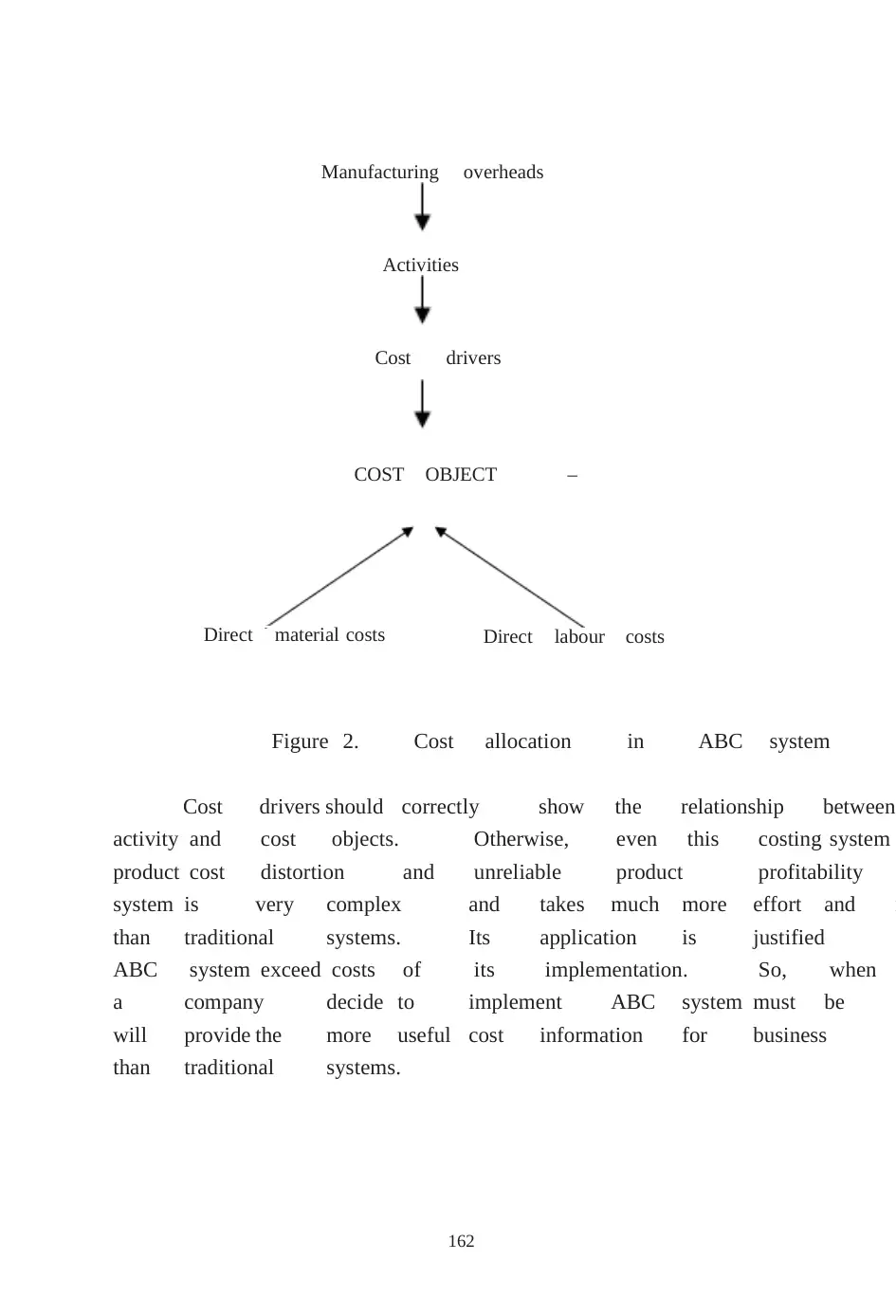
162
Manufacturing overheads
Figure 2. Cost allocation in ABC system
Cost drivers should correctly show the relationship between
activity and cost objects. Otherwise, even this costing system
product cost distortion and unreliable product profitability
system is very complex and takes much more effort and r
than traditional systems. Its application is justified o
ABC system exceed costs of its implementation. So, when
a company decide to implement ABC system must be s
will provide the more useful cost information for business d
than traditional systems.
Activities
Cost drivers
COST OBJECT –
Direct material costs Direct labour costs
Manufacturing overheads
Figure 2. Cost allocation in ABC system
Cost drivers should correctly show the relationship between
activity and cost objects. Otherwise, even this costing system
product cost distortion and unreliable product profitability
system is very complex and takes much more effort and r
than traditional systems. Its application is justified o
ABC system exceed costs of its implementation. So, when
a company decide to implement ABC system must be s
will provide the more useful cost information for business d
than traditional systems.
Activities
Cost drivers
COST OBJECT –
Direct material costs Direct labour costs
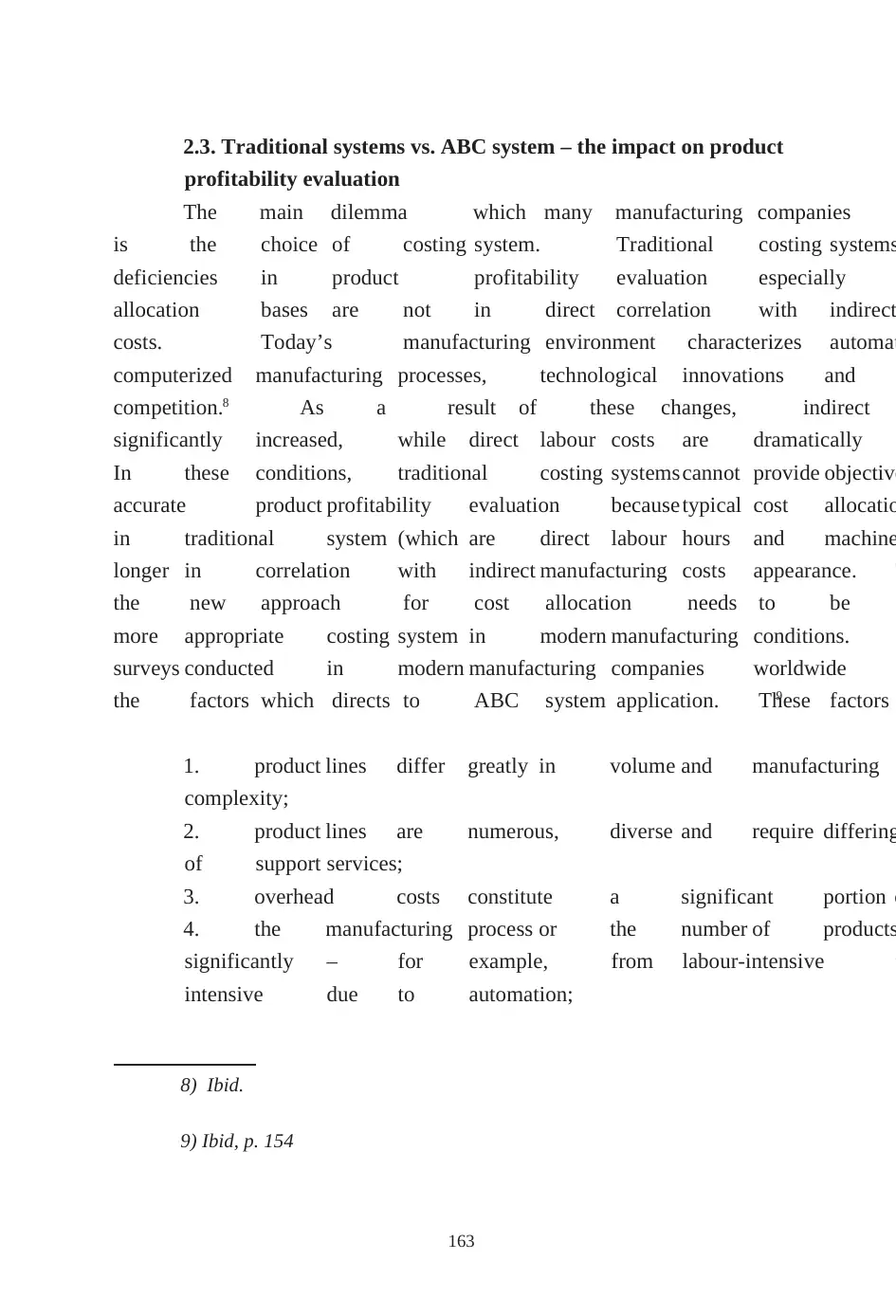
163
2.3. Traditional systems vs. ABC system – the impact on product
profitability evaluation
The main dilemma which many manufacturing companies
is the choice of costing system. Traditional costing systems
deficiencies in product profitability evaluation especially
allocation bases are not in direct correlation with indirect
costs. Today’s manufacturing environment characterizes automat
computerized manufacturing processes, technological innovations and g
competition.8 As a result of these changes, indirect
significantly increased, while direct labour costs are dramatically d
In these conditions, traditional costing systemscannot provide objective
accurate product profitability evaluation becausetypical cost allocatio
in traditional system (which are direct labour hours and machine
longer in correlation with indirect manufacturing costs appearance. T
the new approach for cost allocation needs to be
more appropriate costing system in modern manufacturing conditions. M
surveys conducted in modern manufacturing companies worldwide i
the factors which directs to ABC system application. These factors9
1. product lines differ greatly in volume and manufacturing
complexity;
2. product lines are numerous, diverse and require differing
of support services;
3. overhead costs constitute a significant portion o
4. the manufacturing process or the number of products
significantly – for example, from labour-intensive t
intensive due to automation;
8) Ibid.
9) Ibid, p. 154
2.3. Traditional systems vs. ABC system – the impact on product
profitability evaluation
The main dilemma which many manufacturing companies
is the choice of costing system. Traditional costing systems
deficiencies in product profitability evaluation especially
allocation bases are not in direct correlation with indirect
costs. Today’s manufacturing environment characterizes automat
computerized manufacturing processes, technological innovations and g
competition.8 As a result of these changes, indirect
significantly increased, while direct labour costs are dramatically d
In these conditions, traditional costing systemscannot provide objective
accurate product profitability evaluation becausetypical cost allocatio
in traditional system (which are direct labour hours and machine
longer in correlation with indirect manufacturing costs appearance. T
the new approach for cost allocation needs to be
more appropriate costing system in modern manufacturing conditions. M
surveys conducted in modern manufacturing companies worldwide i
the factors which directs to ABC system application. These factors9
1. product lines differ greatly in volume and manufacturing
complexity;
2. product lines are numerous, diverse and require differing
of support services;
3. overhead costs constitute a significant portion o
4. the manufacturing process or the number of products
significantly – for example, from labour-intensive t
intensive due to automation;
8) Ibid.
9) Ibid, p. 154
⊘ This is a preview!⊘
Do you want full access?
Subscribe today to unlock all pages.

Trusted by 1+ million students worldwide
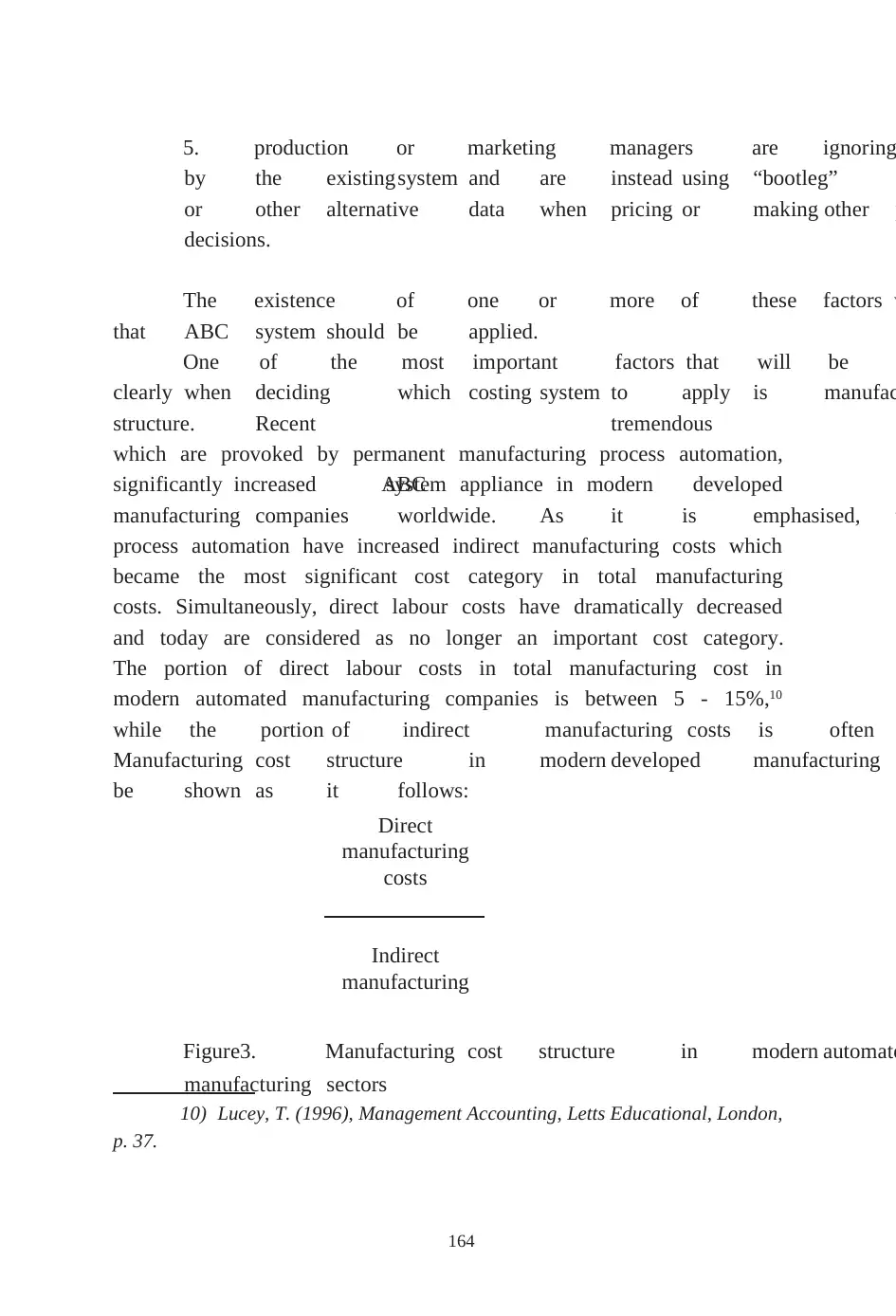
164
5. production or marketing managers are ignoring
by the existingsystem and are instead using “bootleg” c
or other alternative data when pricing or making other p
decisions.
The existence of one or more of these factors w
that ABC system should be applied.
One of the most important factors that will be
clearly when deciding which costing system to apply is manufac
structure. Recent tremendous c
which are provoked by permanent manufacturing process automation,
significantly increased ABCsystem appliance in modern developed
manufacturing companies worldwide. As it is emphasised, t
process automation have increased indirect manufacturing costs which
became the most significant cost category in total manufacturing
costs. Simultaneously, direct labour costs have dramatically decreased
and today are considered as no longer an important cost category.
The portion of direct labour costs in total manufacturing cost in
modern automated manufacturing companies is between 5 - 15%,10
while the portion of indirect manufacturing costs is often
Manufacturing cost structure in modern developed manufacturing s
be shown as it follows:
Figure3. Manufacturing cost structure in modern automate
manufacturing sectors
10) Lucey, T. (1996), Management Accounting, Letts Educational, London,
p. 37.
Direct
manufacturing
costs
Indirect
manufacturing
5. production or marketing managers are ignoring
by the existingsystem and are instead using “bootleg” c
or other alternative data when pricing or making other p
decisions.
The existence of one or more of these factors w
that ABC system should be applied.
One of the most important factors that will be
clearly when deciding which costing system to apply is manufac
structure. Recent tremendous c
which are provoked by permanent manufacturing process automation,
significantly increased ABCsystem appliance in modern developed
manufacturing companies worldwide. As it is emphasised, t
process automation have increased indirect manufacturing costs which
became the most significant cost category in total manufacturing
costs. Simultaneously, direct labour costs have dramatically decreased
and today are considered as no longer an important cost category.
The portion of direct labour costs in total manufacturing cost in
modern automated manufacturing companies is between 5 - 15%,10
while the portion of indirect manufacturing costs is often
Manufacturing cost structure in modern developed manufacturing s
be shown as it follows:
Figure3. Manufacturing cost structure in modern automate
manufacturing sectors
10) Lucey, T. (1996), Management Accounting, Letts Educational, London,
p. 37.
Direct
manufacturing
costs
Indirect
manufacturing
Paraphrase This Document
Need a fresh take? Get an instant paraphrase of this document with our AI Paraphraser
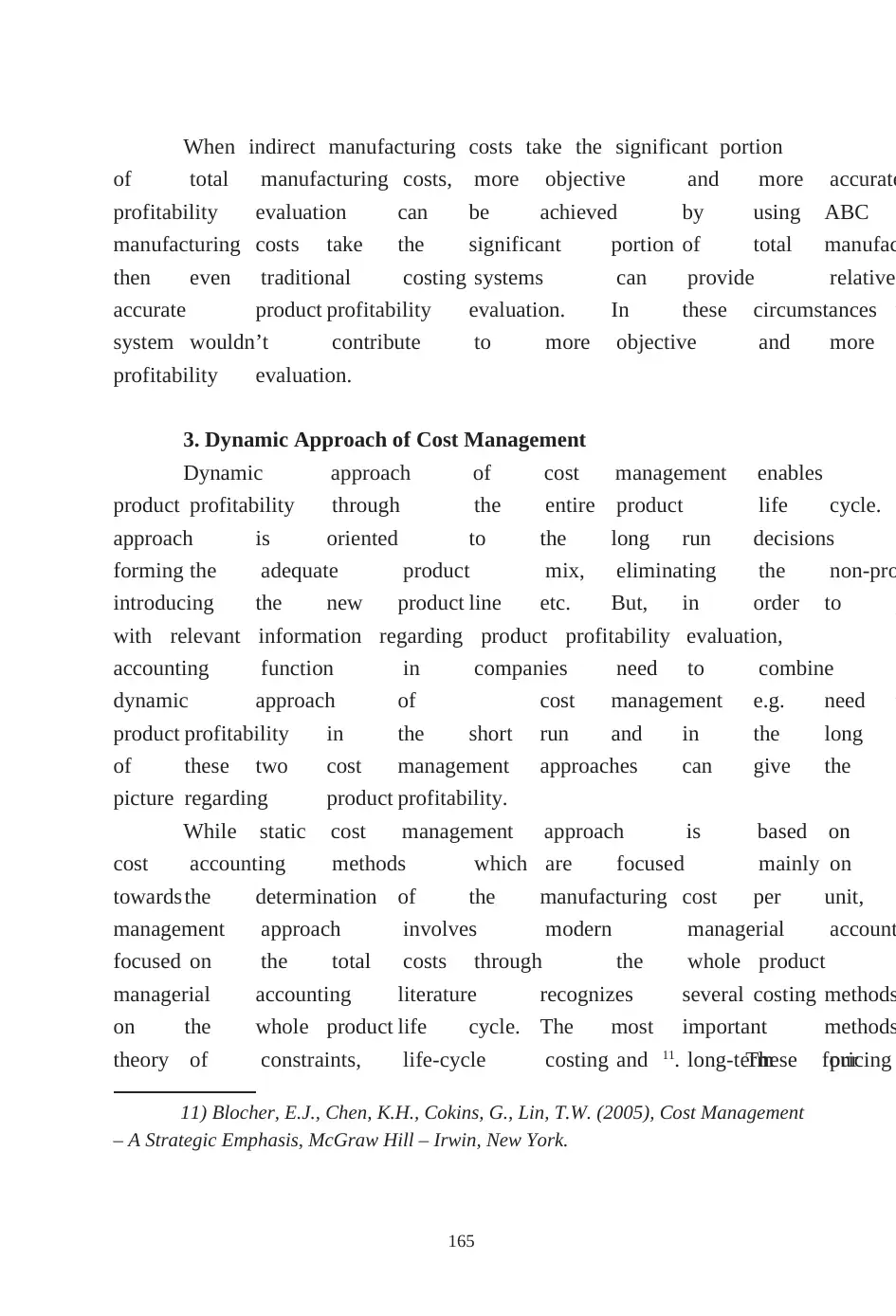
165
When indirect manufacturing costs take the significant portion
of total manufacturing costs, more objective and more accurate
profitability evaluation can be achieved by using ABC s
manufacturing costs take the significant portion of total manufac
then even traditional costing systems can provide relativel
accurate product profitability evaluation. In these circumstances u
system wouldn’t contribute to more objective and more
profitability evaluation.
3. Dynamic Approach of Cost Management
Dynamic approach of cost management enables
product profitability through the entire product life cycle.
approach is oriented to the long run decisions r
forming the adequate product mix, eliminating the non-pro
introducing the new product line etc. But, in order to p
with relevant information regarding product profitability evaluation,
accounting function in companies need to combine
dynamic approach of cost management e.g. need t
product profitability in the short run and in the long r
of these two cost management approaches can give the o
picture regarding product profitability.
While static cost management approach is based on
cost accounting methods which are focused mainly on
towardsthe determination of the manufacturing cost per unit, d
management approach involves modern managerial account
focused on the total costs through the whole product
managerial accounting literature recognizes several costing methods
on the whole product life cycle. The most important methods
theory of constraints, life-cycle costing and long-term pricing11. These four
11) Blocher, E.J., Chen, K.H., Cokins, G., Lin, T.W. (2005), Cost Management
– A Strategic Emphasis, McGraw Hill – Irwin, New York.
When indirect manufacturing costs take the significant portion
of total manufacturing costs, more objective and more accurate
profitability evaluation can be achieved by using ABC s
manufacturing costs take the significant portion of total manufac
then even traditional costing systems can provide relativel
accurate product profitability evaluation. In these circumstances u
system wouldn’t contribute to more objective and more
profitability evaluation.
3. Dynamic Approach of Cost Management
Dynamic approach of cost management enables
product profitability through the entire product life cycle.
approach is oriented to the long run decisions r
forming the adequate product mix, eliminating the non-pro
introducing the new product line etc. But, in order to p
with relevant information regarding product profitability evaluation,
accounting function in companies need to combine
dynamic approach of cost management e.g. need t
product profitability in the short run and in the long r
of these two cost management approaches can give the o
picture regarding product profitability.
While static cost management approach is based on
cost accounting methods which are focused mainly on
towardsthe determination of the manufacturing cost per unit, d
management approach involves modern managerial account
focused on the total costs through the whole product
managerial accounting literature recognizes several costing methods
on the whole product life cycle. The most important methods
theory of constraints, life-cycle costing and long-term pricing11. These four
11) Blocher, E.J., Chen, K.H., Cokins, G., Lin, T.W. (2005), Cost Management
– A Strategic Emphasis, McGraw Hill – Irwin, New York.
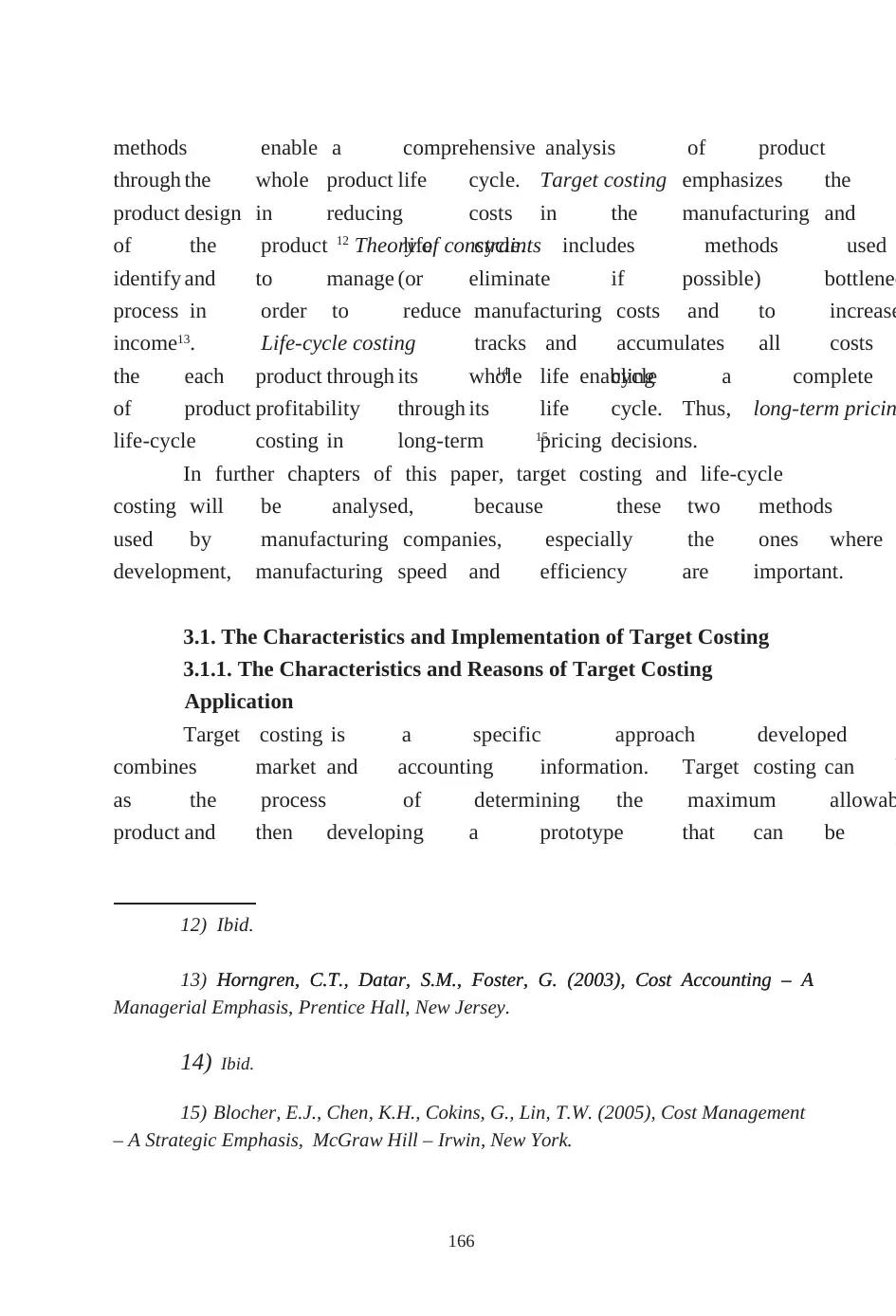
166
methods enable a comprehensive analysis of product
through the whole product life cycle. Target costing emphasizes the r
product design in reducing costs in the manufacturing and d
of the product life cycle.12 Theory of constraints includes methods used
identify and to manage (or eliminate if possible) bottlenec
process in order to reduce manufacturing costs and to increase
income13. Life-cycle costing tracks and accumulates all costs
the each product through its whole life cycle14 enabling a complete
of product profitability through its life cycle. Thus, long-term pricin
life-cycle costing in long-term pricing decisions.15
In further chapters of this paper, target costing and life-cycle
costing will be analysed, because these two methods
used by manufacturing companies, especially the ones where
development, manufacturing speed and efficiency are important.
3.1. The Characteristics and Implementation of Target Costing
3.1.1. The Characteristics and Reasons of Target Costing
Application
Target costing is a specific approach developed
combines market and accounting information. Target costing can b
as the process of determining the maximum allowab
product and then developing a prototype that can be p
12) Ibid.
13) Horngren, C.T., Datar, S.M., Foster, G. (2003), Cost Accounting – AHorngren, C.T., Datar, S.M., Foster, G. (2003), Cost Accounting – A
Managerial Emphasis, Prentice Hall, New Jersey.
14) Ibid.
15) Blocher, E.J., Chen, K.H., Cokins, G., Lin, T.W. (2005), Cost Management
– A Strategic Emphasis, McGraw Hill – Irwin, New York.
methods enable a comprehensive analysis of product
through the whole product life cycle. Target costing emphasizes the r
product design in reducing costs in the manufacturing and d
of the product life cycle.12 Theory of constraints includes methods used
identify and to manage (or eliminate if possible) bottlenec
process in order to reduce manufacturing costs and to increase
income13. Life-cycle costing tracks and accumulates all costs
the each product through its whole life cycle14 enabling a complete
of product profitability through its life cycle. Thus, long-term pricin
life-cycle costing in long-term pricing decisions.15
In further chapters of this paper, target costing and life-cycle
costing will be analysed, because these two methods
used by manufacturing companies, especially the ones where
development, manufacturing speed and efficiency are important.
3.1. The Characteristics and Implementation of Target Costing
3.1.1. The Characteristics and Reasons of Target Costing
Application
Target costing is a specific approach developed
combines market and accounting information. Target costing can b
as the process of determining the maximum allowab
product and then developing a prototype that can be p
12) Ibid.
13) Horngren, C.T., Datar, S.M., Foster, G. (2003), Cost Accounting – AHorngren, C.T., Datar, S.M., Foster, G. (2003), Cost Accounting – A
Managerial Emphasis, Prentice Hall, New Jersey.
14) Ibid.
15) Blocher, E.J., Chen, K.H., Cokins, G., Lin, T.W. (2005), Cost Management
– A Strategic Emphasis, McGraw Hill – Irwin, New York.
⊘ This is a preview!⊘
Do you want full access?
Subscribe today to unlock all pages.

Trusted by 1+ million students worldwide
1 out of 26
Related Documents
Your All-in-One AI-Powered Toolkit for Academic Success.
+13062052269
info@desklib.com
Available 24*7 on WhatsApp / Email
![[object Object]](/_next/static/media/star-bottom.7253800d.svg)
Unlock your academic potential
Copyright © 2020–2025 A2Z Services. All Rights Reserved. Developed and managed by ZUCOL.





